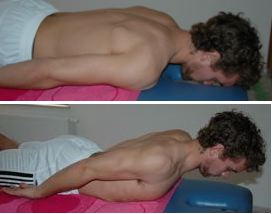The muscles work concentrically, shortening as you lift your trunk, and pay out eccentrically as you control the reverse movement. The back extensor muscles are often undermined by poor postural habits, and invariably following any kind of back problem. The exercise restores muscle tone, making it easier to sit and stand comfortably with the spine in good alignment.
Position: Lie on your stomach with a pillow under your hips. You can have a second pillow under your shins if it is more comfortable. Place a cushion under your forehead, so that you can keep your head straight and still breathe.
Movement: Lift your head and shoulders a little way upwards, bring your shoulder blades together gently; hold for a count of two, then slowly lower your trunk back to the starting position and relax completely.
Repetitions and frequency: 3-5 times at first, building up to 10-20 repetitions, 1-2 times a day.Position: Lie on your stomach with a pillow under your hips. You can have a second pillow under your shins if it is more comfortable. Place a cushion under your forehead, so that you can keep your head straight and still breathe.

Movement: Lift your head and shoulders a little way upwards, bring your shoulder blades together gently; hold for a count of two, then slowly lower your trunk back to the starting position and relax completely.
Note: Avoid pain. If your back is uncomfortable when you lie flat, put a pillow under your hips at first. Only lift a little way, do not try to arch your back to the fullest extent. Lift your head slightly, or keep it in line with your trunk. Try to keep your buttock muscles (gluteals) relaxed. Keep your hands in contact with the floor or bed. Breathe evenly, do not hold your breath. Preferably breathe in as you prepare, breathe out as you lift your head and shoulders, in again as you return to the starting position.
After injury: This is a vital exercise following any kind of back, shoulder, upper back or neck problem, because it helps to correct the movement of the shoulder blades, and to co-ordinate the shoulder girdle with the back and neck muscles.


